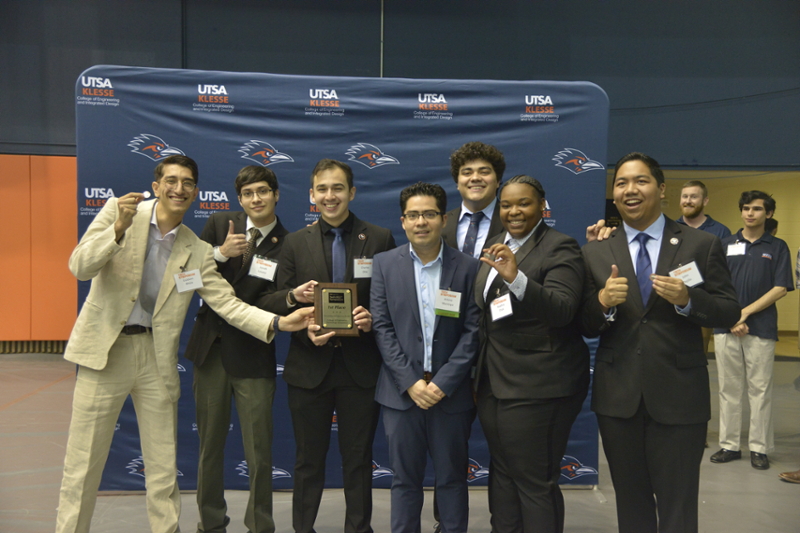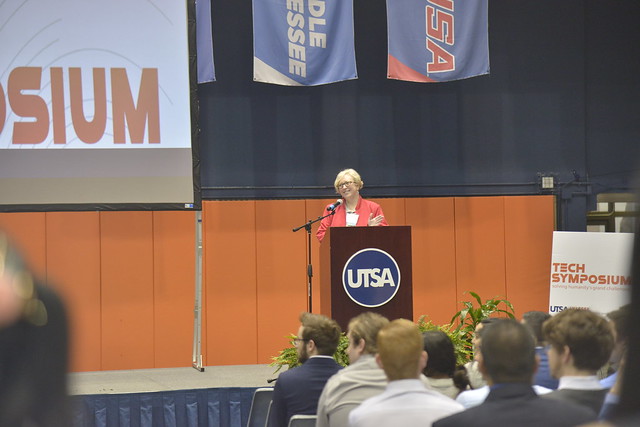
Spring 2023 Winners
UTSA's Klesse College of Engineering and Integrated Design Spring 2023 Tech Symposium took place on Friday, April 28th from 8:30 am-1:30 pm in the Convocation Center on UTSA’s Main Campus
Congratulations to Print & Click, the 1st place winners of the 2023 Spring Tech Symposium!
Biomedical Engineering Design II
traumatized limb with extreme bony defects. Tibiotalocalcaneal (TTC)
Arthrodesis is a limb salvage procedure performed on patients with
Charcot Arthroneuropathy or Charcot foot, a chronic complication of Type
II Diabetes. Eventually, severe bony defects form around the ankle and
may require surgery to remove portions of diseased bone. To fill the bony
void, current technologies involve the use of femoral head allografts and
patient- specific implants. However, these methods are costly, lack
reproducibility, and are difficult to design. The Atlus allows for
osseointegration and ease of implantation. With the novel device,
surgeons may leverage an off-the-shelf product to reduce the reliance on
expensive custom implants.
Balloon angioplasty has traditionally been used in treatment of arterial calcification. While it has been effective in some cases, many shortcomings remain. Today there remain no balloon catheters which can address coronary artery calcification in the smallest coronary arteries, which can be as small as 1.0 mm in diameter. As it stands, standard balloon angioplasty is also unable to successfully break down calcification in chronic cases.
This has led to angioplasty modifications in larger arteries (e.g. peripheral) which now predominantly utilize intravascular lithotripsy to more effectively break down calcification and create better vessel compliance. Intravascular lithotripsy uses a standard balloon catheter to generate and propagate shockwaves which break down and fracture the plaque. Peripheral artery approaches consist of electrode-based lithotripsy as seen in the main competitor Shockwave IVL. While this technology is effective, it is unable to be scaled down to the size of the coronary arteries given its use of electrode-based technology.
Referring back to traditional laser lithotripsy approaches in the kidneys, this design intends to adapt lithotripsy techniques through the use of optical laser fibers. Such a technique allows for the construction of a laser lithotripsy balloon catheter which has the ability to treat coronary artery calcification in the smallest arteries.
This proposed project is the development of a robotic probe holder for use as an attachment to a robotic arm system to perform automatic ultrasound imaging. The main focus of this device is to adjust to multiple probe sizes and shapes, to deliver gel to the tissue surface at each point of the exam, and to ensure adequate force is being applied to the patient.
The purpose of this project is to design a safe and biocompatible device that is an improvement of the current commercially available catheter-based miniaturized ventricular assist device that pumps blood from the left ventricle (LV) into the ascending aorta and would be responsible for systemic circulation.
The goal is to implement three electrodes into a commercially available pLVAD with the intention of measuring the volume in cardiac output (CO) to obtain accurate measurements and perform calculations in real-time for automated pump weaning.
Chemical Engineering Design II
Civil Engineering Design II
To capitalize on this growth, Encore Engineering is proposing a 7,000 square foot commercial development, on 1819 Sonterra Blvd, San Antonio, TX, 78259, a 5.0-acre lot on the intersection of East Sonterra Boulevard and Ridgewood Parkway. The structure will be a local brewery that will produce crafted beer. The site will also serve as a bar with an outside garden which will have popular, classic games such as giant chess sets.
Electrical & Computer Engineering Design I
engineering design project between the electrical and computer engineering (ECE) program and the biomechanical engineering program. The goal of the project is to create a portable suction device that is able to effectively clear airway obstructions—blockage of respiration due to foreign body, trauma or infection. Through a minimally invasive procedure, the device uses negative pressure to draw the obstruction from the patient’s airway. The ECE design team is tasked with developing the electrical system that is comprised of two subsystems, a low-power and high-power. The low-power subsystem will include the microcontroller, which will function as the “brain” of the device, as well as the user interface, which consists of LED indicators and a digital display. The high-power subsystem will be used to provide power for the pump motor. Using this two-subsystem setup, this device will provide a comprehensive and intuitive user-interface as well as user relegated suction speed
valuable device allows for the simulation of hemorrhage-like conditions, leading to the
development of improved medical treatments. Our team is working on upgrading the existing
LBNP chamber by replacing some of its physiology sensors and vacuum pump, as well as
upgrading its software to enhance the user experience. These upgrades will contribute to the
continued advancement of medical research and improve the understanding of the physiological
responses to hemorrhage-like conditions.
access the user’s phone to display weather information, play music, record to notes, and interact with user’s calendar. The AI desktop assistant is designed to detect certain voice commands to provide features tailored to the user’s order.
Using image processing techniques, such as targeting and various morphological tools, this product will identify and read the structure representing UDI for the medical implant from an x-ray image. The UDI can contain information such as manufacturer, date, device model, and lot/batch.
Electrical & Computer Engineering Design II
of the most significant issues faced by drivers in a
parking lot, especially at UTSA. The proposed solution is a mobile
application based on the development of a pre-mapped of
the parking space and a scanner that informs about the
free or empty space in a parking lot. The mobile
application is highly efficient and offers distinct features
such as real-time updates and statistics on the free parking
spaces along with the closest free spots based on the
user’s location.
To accommodate this need, the research team has requested students to design a system which achieves boresight-to-boresight alignment within 15 minutes and with an accuracy within 0.025 degrees. While the student team was not able to obtain equipment to operate at Ka-band levels, the team was able to utilize S-band equipment in a hardware-software approach using software-defined radios and microcontrollers to satisfy constraints.
continuously ensuring the safety of the user via third-party software that checks the ozone concentration levels.
EPICS
1. To clean up, sort, and distribute materials gathered from the site to then send to remanufacturing firms.
2. To gain understanding regarding where the trash/debris is coming from and why our society is tolerant of this sort of illegal dumping.
Mechanical Engineering Design I
The project's commercial rationale is to present SwRI's clients with a clear and detailed visual representation of their products' fire test results. By providing a live view into the chamber, SwRI can not only communicate with their clients more effectively about their products, but also present the results in a more accessible and visually compelling manner, surpassing the limitations of raw data.
The camera assembly must be able to capture video throughout the entire duration of the test, even under temperatures exceeding 2000 F for several hours. The system's design ensures its durability and longevity, making it an invaluable asset for any high-temperature testing applications.
Mechanical Engineering Design II
awaiting palletization. Palletizing is a repetitive and
laborious process including cleaning, drying, and
inspecting. Presently, it is manually completed by a
human operator. This non-value-added operation is
considered waste in the Manufacturing Industry since
it removes operators from value-added processes.
Currently, no device exists to automatically palletize
parts exiting CNC machines. JMDP has designed an
Automated Part Palletizer to eliminate the need for a
human operator when palletizing, allowing them to
complete more complex, value-added tasks.
and building an automated disposal system to lift and
dump heavy debris into the roll-off dumpsters located
at Newton Home Improvement’s worksites. This will
reduce the workplace fatigue and risk of injury
associated with their construction personnel. A
preliminary SolidWorks design was created by the
Lazy Lifters that utilizes a scissor lift mechanism
paired with an actuator.



